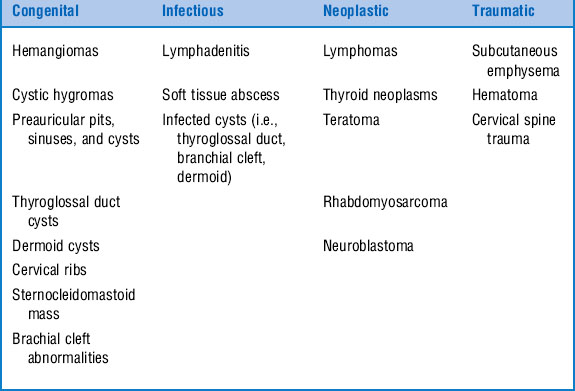CHAPTER 20 Neck Masses
6 List the anatomic classifications of a neck mass, with the most common masses in each category.
TABLE 20-2 THE ANATOMIC CLASSIFICATIONS OF A NECK MASS, WITH THE MOST COMMON MASSES IN EACH CATEGORY
| Midline | Lateral |
|---|---|
| Thyroglossal duct cyst | Lymphadenopathy |
| Lymphadenopathy | Cystic hygroma |
| Dermoid cyst | Branchial cleft cyst |
| Epidermoid cyst | Sternocleidomastoid mass |
| Sialadenitis | Parotitis |
| Ectopic thyroid tissue | Thyroid gland tumors |
7 How is the workup of a child with a neck mass conducted?
Gross E, Sichel JY: Congenital neck lesions. Surg Clin North Am 86:383–392, 2006.
9 What are the most common locations of cystic hygromas?
They develop in close proximity to large veins and lymphatic ducts:
10 What is the most serious complication of cystic hygroma? What are the treatments for this condition?
Koch BL: Cystic malformations of the neck in children. Pediatr Radiol 35:463–477, 2005.
14 What are the treatments for hemangiomas?
Connor SE, Flis C, Langdon JD: Vascular masses of the head and neck. Clin Radiol 60:856–868, 2005.
18 Compare dermoid and epidermoid cysts.
| Features | Dermoid Cyst | Epidermoid Cyst |
|---|---|---|
| Origins | Congenital | Traumatic or inflammatory |
| Inclusion of embryonic epidermis within embryonal fusion planes | Follicular infundibulum of the hair shaft | |
| Location | Head and neck: lateral to the supraorbital palpebral ridge, midline face, especially nasal bridge or neck | Head and neck: lateral to the supraorbital palpebral ridge, midline face, especially nasal bridge or neck |
| Contents | Lined by epithelium and contain sebaceous glands, hair follicles, connective tissues, and papillae | Lined by epithelium, does not contain cutaneous appendages but rather keratinized cellular debris |
| Treatment | Surgical excision | Surgical excision |
25 What is the most common cause of acute cervical lymph node enlargement?
 Viral: Severe viral pharyngitis can cause cervical lymph nodes to enlarge acutely, usually bilaterally. Infections of the upper respiratory tract can lead to lymph node enlargement. Agents include influenza A and B viruses, Epstein-Barr virus, rhinovirus, enterovirus, and adenovirus.
Viral: Severe viral pharyngitis can cause cervical lymph nodes to enlarge acutely, usually bilaterally. Infections of the upper respiratory tract can lead to lymph node enlargement. Agents include influenza A and B viruses, Epstein-Barr virus, rhinovirus, enterovirus, and adenovirus.
 Bacterial: Acute suppurative cervical lymphadenitis secondary to bacterial infection is another cause for cervical lymph node enlargement. Common bacterial pathogens include Staphylococcus aureus, group A β-hemolytic streptococci, Streptococcus pneumoniae (rarely), anaerobes from mouth flora, and Bartonella henselae (cat scratch disease).
Bacterial: Acute suppurative cervical lymphadenitis secondary to bacterial infection is another cause for cervical lymph node enlargement. Common bacterial pathogens include Staphylococcus aureus, group A β-hemolytic streptococci, Streptococcus pneumoniae (rarely), anaerobes from mouth flora, and Bartonella henselae (cat scratch disease).
29 What is the workup for a child with subacute or chronic cervical lymphadenitis?
 Perform a complete history and physical examination.
Perform a complete history and physical examination.
 Note the child’s overall general appearance.
Note the child’s overall general appearance.
 Assess the number, size, and location of lymph nodes.
Assess the number, size, and location of lymph nodes.
 Consider laboratory studies, including complete blood count with differential, ESR, chest x-ray, and a purified protein derivative test.
Consider laboratory studies, including complete blood count with differential, ESR, chest x-ray, and a purified protein derivative test.
 Begin antibiotics to cover staphylococcus and streptococcus.
Begin antibiotics to cover staphylococcus and streptococcus.
 Arrange for the patient to be followed closely by his or her primary care physician.
Arrange for the patient to be followed closely by his or her primary care physician.
33 Describe the most common neoplasm of the neck based on age.
Approximately 5% of all neoplastic lesions occur in the head and neck region.










































